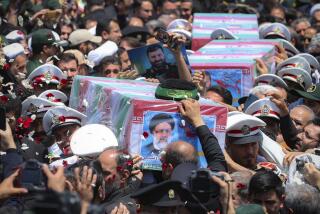70 Coffins a Grim Centerpiece : Tehran Mourns, Calls for ‘Death to America’
- Share via
TEHRAN — “Revenge, revenge, revenge!” chanted the crowd in front of the white marble Iranian Parliament building Thursday, where more than 70 coffins were placed side by side.
The dozens of wooden coffins, of adults and children alike, were the grim centerpiece in a funeral procession and demonstration against the United States to mourn the 290 victims of the downing of an Iran Air jetliner by the U.S. Navy cruiser Vincennes last Sunday.
An estimated 5,000 to 10,000 Iranians, many of them weeping, attended the two-hour ceremony and repeatedly called “Death to America!” as they raised their clenched fists in anger. But it was a modest turnout by Tehran’s standards, where hundreds of thousands have assembled on emotional occasions in the past.
In the heat of the summer morning, blue-capped police and camouflage-clad soldiers sprayed cooling water on both the crowd and the coffins, which bore red-white-and-green Iranian flags topped by gladiolas.
President Ali Khamenei, calling the downing of the plane “murder,” nonetheless indicated that revenge would not be extracted through terrorist acts. Instead, the conservative clergyman exhorted the crowd to focus their anger on Iran’s nearly eight-year war with Iraq, in which Baghdad seems to have the current advantage.
Considers Public Opinion
“To take one or two persons hostage, whether that person is an ordinary one or a diplomat, or even a security individual--if such a person is taken captive in any corner of the world, public opinion does not like it,” Khamenei declared.
In front of the surprisingly modern Parliament building was a large picture of an American flag with the U.S. presidential seal superimposed--with an Iranian flagstaff symbolically driven through it.
Dozens of turbaned Islamic clerics, or mullahs, many of them members of Parliament, sat cross-legged at the top of the building’s steps. Above them, flanking a huge placard reading “Allah,” were portraits of the ailing national leader, the Ayatollah Ruhollah Khomeini, who did not attend, and of Khamenei.
The bearded president stood below the placards, alongside Hashemi Rafsanjani, the powerful Speaker of Parliament and the commander of the armed forces, whose difficult job it is to reverse a series of military defeats in the war against Iraq.
Khamenei, clad in a white turban and robe, accused the United States of “covering up” its real role in the disaster. In an apparent reference to the U.S. Embassy hostages captured in Tehran in 1979 and held for 444 days, he declared that although “they were held for a long time, they were not killed.”
He said President Reagan and his Cabinet were responsible for the tragedy, and he called on governments worldwide to support Iran against the United States “in this incident.”
Khamenei promised that Tehran “will not accept humiliation from the U.S.” and insisted that in the future the Iranian government and people will have “the right of revenge in any form” they choose.
Hectic Procession
At the end of the president’s speech, near-hysterical members of the crowd surged forward to lift the coffins overhead in a hectic procession toward Behesht Zahra, “the Cemetery of the Martyrs,” a burial ground for victims of the Iran-Iraq War.
Khamenei, Rafsanjani and the Ayatollah Hussein Ali Montazeri, Khomeini’s designated successor, led the march through downtown Tehran and Hassan Abad Square, as many in the crowd beat themselves in a traditional sign of sorrow.
Other ceremonies were held in the southern cities of Lar and Zahedan--and in Bandar Abbas, the port city from which the jetliner left Sunday on its last flight to Dubai, in the United Arab Emirates. A total of 14 victims were buried Wednesday in Bandar Abbas, while 10 more were buried at Zahedan, according to Iranian television reports.
Western diplomats pointed out later that Rafsanjani--thought to be the second-most powerful man in the country--chose not to speak on this occasion.
Rafsanjani Preoccupied
Rafsanjani is said by Western observers to be too preoccupied with grave problems concerning the conduct of the war, the faltering economy and the political succession to Khomeini to become overly involved in the current anti-American propaganda campaign.
Meanwhile, the chief of the Iranian air force charged Thursday that the Vincennes had 21 minutes in which to identify the Iran Air Airbus A-300 as a civilian aircraft, contradicting the Navy’s argument that the ship had only a few minutes in which to distinguish the airliner from a hostile F-14 fighter before shooting it down with missiles.
At the same time, Brig. Gen. Mansour Satari declared that crewmen on the Vincennes were “incapable of controlling sophisticated equipment” if they could not make the distinction between the wide-bodied airliner and the two-person F-14.
Transponder Turned On
According to Satari, the Airbus’ pilot was in contact with the control tower in Bandar Abbas when he started his engines and was instructed to turn on his transponder, which emits identifying radar signals. Satari said the Iranian government has tapes of the conversations.
More to Read
Sign up for Essential California
The most important California stories and recommendations in your inbox every morning.
You may occasionally receive promotional content from the Los Angeles Times.










